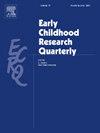研究幼儿从绘画到早期写作的过渡
IF 3.1
1区 教育学
Q1 EDUCATION & EDUCATIONAL RESEARCH
引用次数: 0
摘要
检查幼儿在绘画方面的进展,从潦草的线条到人物、地点和物体的图形表示,再到字母符号的书写,可以为了解早期认知、语言和运动发展打开一扇窗。在目前的混合方法调查中,我们首先回顾了关于这种过渡的先前文献,其中包括对标记制作,绘画和早期写作的阶段或顺序的讨论。然后,我们讨论了现有的人体素描、姓名写作、早期写作、口头语言(儿童描述每个绘画/写作样本的平均话语长度)和内容主题的测量方法。接下来,对于5个3-5岁的在大学附属学前班就读的孩子,我们从档案材料中检查了重复的绘画和早期写作,每个孩子的样本从23到73不等。每个案例研究都包括(a)对每个孩子进步的叙述性描述和(b)对所包括措施的分数的分析。为了准备一个更大的研究,包括定期和更多的数据密集样本进行盲法评分,我们提供了每个孩子和孩子之间的比较-具有线性趋势和高度的个体差异-关于在基础学龄前时期图形符号系统(即绘画和早期写作)的发展。本文章由计算机程序翻译,如有差异,请以英文原文为准。
Examining young children’s transitions from drawing into early writing
Examining young children’s progressions in drawing, from scribble lines to graphic representations of people, places, and objects—to their writing of alphabetic symbols—may open windows into knowledge of early cognitive, language, and motor development. In the present mixed-method investigation, we first review prior literature on such transitions, which includes discussion of the stages or sequences of mark-making, drawing, and early writing. We then discuss existing measures of human figure drawings, name writing, early writing, oral language (mean length of utterance of the child’s descriptions of each drawing/writing sample), and content themes. Next, for five children aged 3-5 years attending a university-affiliated preschool, we examine repeated sets of drawings and early writings, ranging from 23 to 73 samples per child, from archival materials. Each case study includes both (a) narrative descriptions of each child’s progressions and (b) analyses of scores on the included measures. With the overall aim of preparing for a larger study that includes regular and more data-intensive samples subject to blinded scoring, we provide comparisons within each child and across children—featuring linear trends and high intra-individual variability– regarding development of graphic symbol systems (i.e., drawing and early writing) during the foundational preschool years.
求助全文
通过发布文献求助,成功后即可免费获取论文全文。
去求助
来源期刊

Early Childhood Research Quarterly
Multiple-
CiteScore
7.00
自引率
8.10%
发文量
109
期刊介绍:
For over twenty years, Early Childhood Research Quarterly (ECRQ) has influenced the field of early childhood education and development through the publication of empirical research that meets the highest standards of scholarly and practical significance. ECRQ publishes predominantly empirical research (quantitative or qualitative methods) on issues of interest to early childhood development, theory, and educational practice (Birth through 8 years of age). The journal also occasionally publishes practitioner and/or policy perspectives, book reviews, and significant reviews of research. As an applied journal, we are interested in work that has social, policy, and educational relevance and implications and work that strengthens links between research and practice.
 求助内容:
求助内容: 应助结果提醒方式:
应助结果提醒方式:


